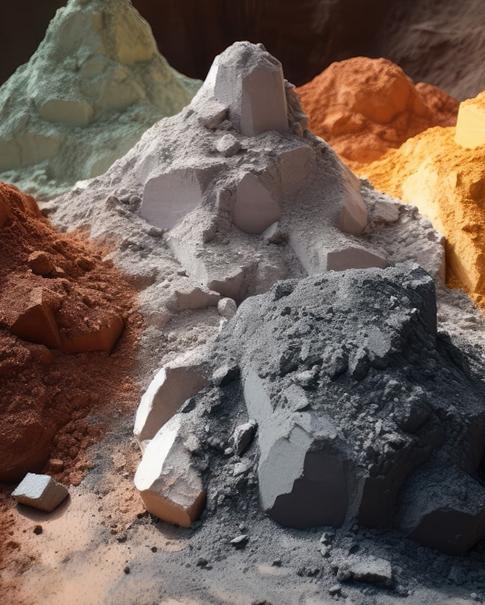-
Give us a call +86 -755-25432352
-
Email us info@urbanmines.com
-
Come & visit us No. 11, Bld. C, Hengmingzhu Tech. Industrial Park, Shajing Subdistrict, Bao'an District, Shenzhen, Guangdong, China
Give us a call +86 -755-25432352
Email us info@urbanmines.com
Come & visit us No. 11, Bld. C, Hengmingzhu Tech. Industrial Park, Shajing Subdistrict, Bao'an District, Shenzhen, Guangdong, China

Lanthanum Hexaboride (LaB6, also called Lanthanum Boride and LaB) is an inorganic chemical, a boride of lanthanum. As refractory ceramic material that has a melting point of 2210 °C, Lanthanum Boride is highly insoluble in water and hydrochloric acid, and converts to the oxide when heated (calcined). Stoichiometric samples are colored intense purple-violet, while boron-rich ones (above LaB6.07) are blue. Lanthanum Hexaboride (LaB6) is known for its hardness, mechanical strength, thermionic emission, and strong plasmonic properties. Recently, a new moderate-temperature synthetic technique was developed to directly synthesize LaB6 nanoparticles.
Lanthanum Hexaboride
| Synonym | Lanthanum Boride |
| CASNo. | 12008-21-8 |
| Chemical formula | LaB6 |
| Molar mass | 203.78g/mol |
| Appearance | intense purple violet |
| Density | 4.72g/cm3 |
| Melting point | 2,210°C(4,010°F;2,480K) |
| Solubility in water | insoluble |
Particle Size of Lanthanum Hexaboride
50nm 100nm 500nm 1μm 5μm 8μm1 2μm 18μm 25μm
What is Lanthanum Hexaboride (LaB₆) used for?
Applications of Lanthanum Hexaboride (LaB₆)
Lanthanum Hexaboride (LaB₆), a rare-earth boride compound, is renowned for its exceptional electron emission properties, thermal stability, and chemical resistance. Its unique combination of high melting point (~2,710°C), low work function, and durability makes it indispensable in advanced electronics, analytical instrumentation, and cutting-edge technologies. Below are its key uses:
1. High-Performance Electron Emission Systems
Electron Beam Sources:
Superior Cathode Material: Replaces traditional tungsten cathodes in high-power electron emission systems due to its lower work function** (2.4–2.8 eV) and higher current density, ensuring brighter, more stable electron beams.
Critical Applications:
Electron Microscopes: Enhances resolution and longevity in scanning electron microscopes (SEMs) and transmission electron microscopes (TEMs).
Electron Beam Lithography: Enables ultra-precise nanofabrication for semiconductor and photonic devices.
Free Electron Lasers (FELs): Powers high-energy electron beams for scientific research and medical imaging.
Microwave & Vacuum Tubes:
Used in magnetrons, klystrons, and traveling-wave tubes (TWTs) for radar systems, satellite communications, and defense technologies.
2. Advanced Manufacturing & Materials Science
Electron Beam Welding & Heating:
Provides highly focused heat sources for precision welding, additive manufacturing, and surface treatment in aerospace and automotive industries.
Coatings & Thin Films:
Applied as protective coatings on turbine blades, rocket nozzles, and nuclear reactor components to resist extreme temperatures and oxidation.
Single-Crystal LaB₆:
Serves as a premium cathode material in particle accelerators, synchrotrons, and ion implantation systems.
3. Analytical Instrumentation
X-Ray Diffraction (XRD) Standards:
Acts as a certified size/strain reference material to calibrate instrumental broadening in XRD analysis, ensuring accuracy in crystallographic studies.
X-Ray Tubes:
Enhances brightness and efficiency in medical and industrial X-ray sources.
4. Emerging & Niche Technologies
Quantum Computing & Research:
Investigated for use in quantum emitters and spintronic devices due to its low electron scattering and high carrier mobility.
Plasma Display Panels (PDPs):
Improves efficiency and lifespan in high-definition displays.
Space Exploration:
Utilized in ion thrusters and spacecraft sensors for deep-space missions.
5. Industrial & Environmental Applications
High-Temperature Sensors:
Functions in thermocouples and thermal probes for metallurgical processes and molten metal monitoring.
Superconducting Materials:
Explored in superconducting composites for energy storage and magnetic levitation systems.
Key Advantages of LaB₆
Ultra-High Thermal Stability: Maintains performance in extreme environments (up to 1,800°C in vacuum).
Chemical Inertness: Resists corrosion from acids, alkalis, and reactive gases.
Longevity: Outperforms tungsten cathodes by 10–20x in operational lifespan.
Industry-Specific Benefits
Aerospace & Defense: Reliable radar systems, satellite communications, and thermal protection coatings.
Semiconductors: Enables next-generation lithography for sub-5nm chip fabrication.
Research & Healthcare: High-resolution imaging in TEMs and advanced X-ray diagnostics.
Lanthanum Hexaboride is a cornerstone of modern high-tech industries, driving innovation in nanotechnology, energy, and quantum sciences. Its unparalleled electron emission capabilities and robustness solidify its role as a critical material for both current and next-generation technologies.
Note: LaB₆ nanoparticles are increasingly used in field-emission displays (FEDs) and nanoelectronics, highlighting its adaptability to evolving technological demands.
Tags :